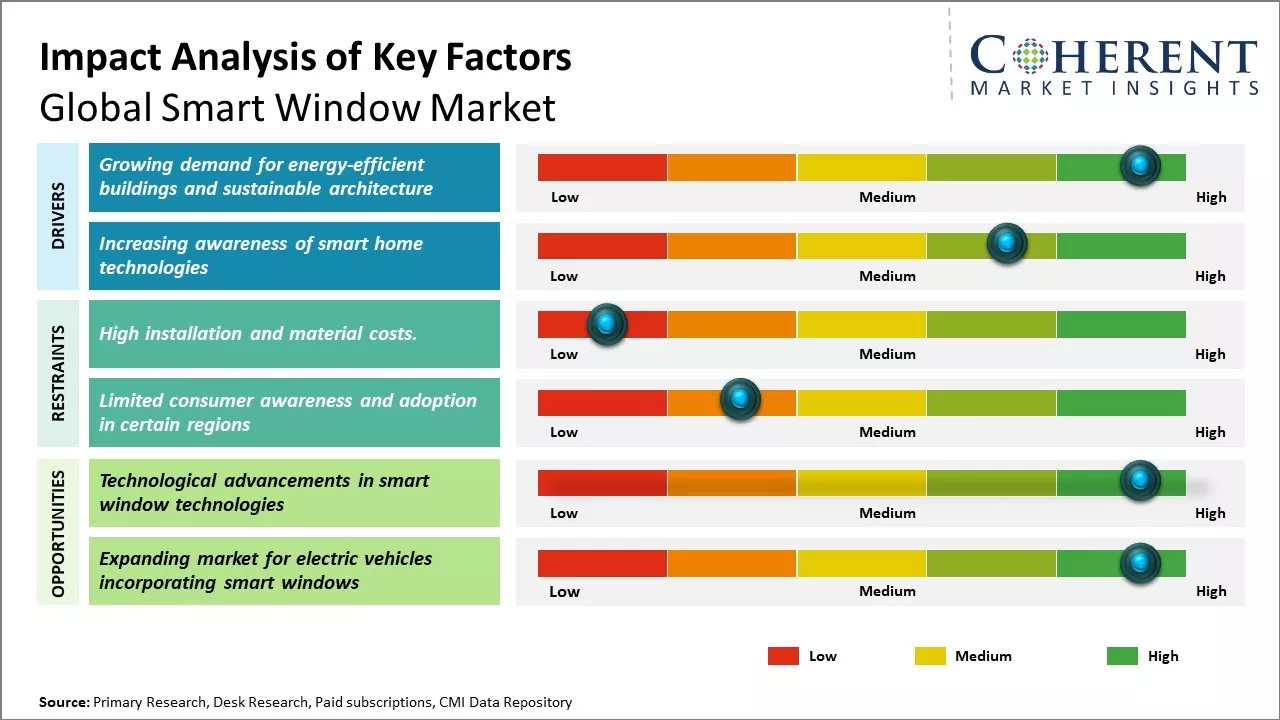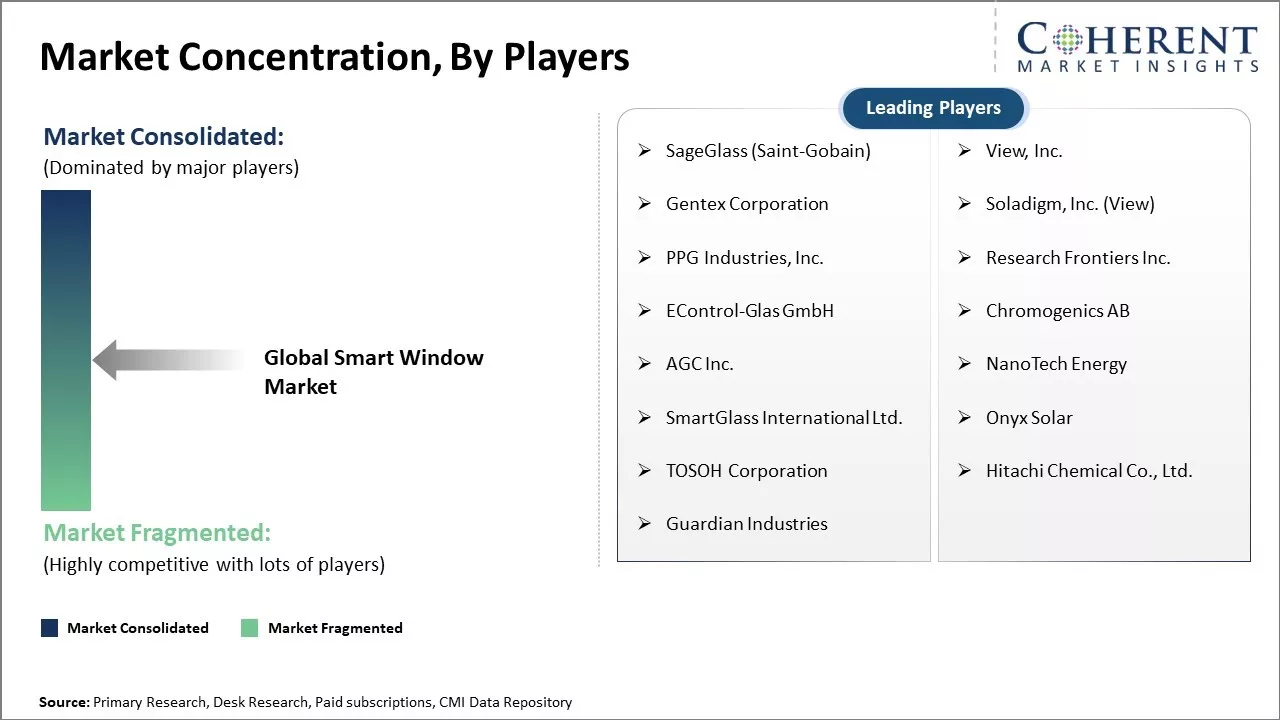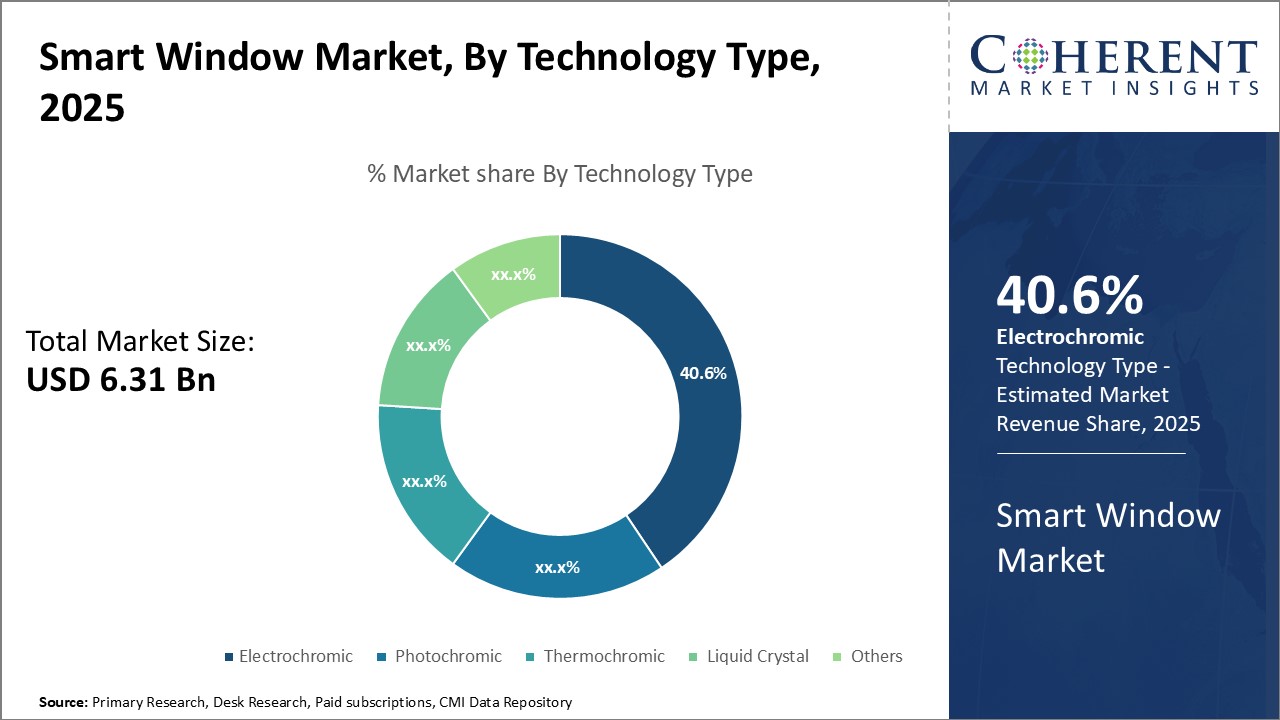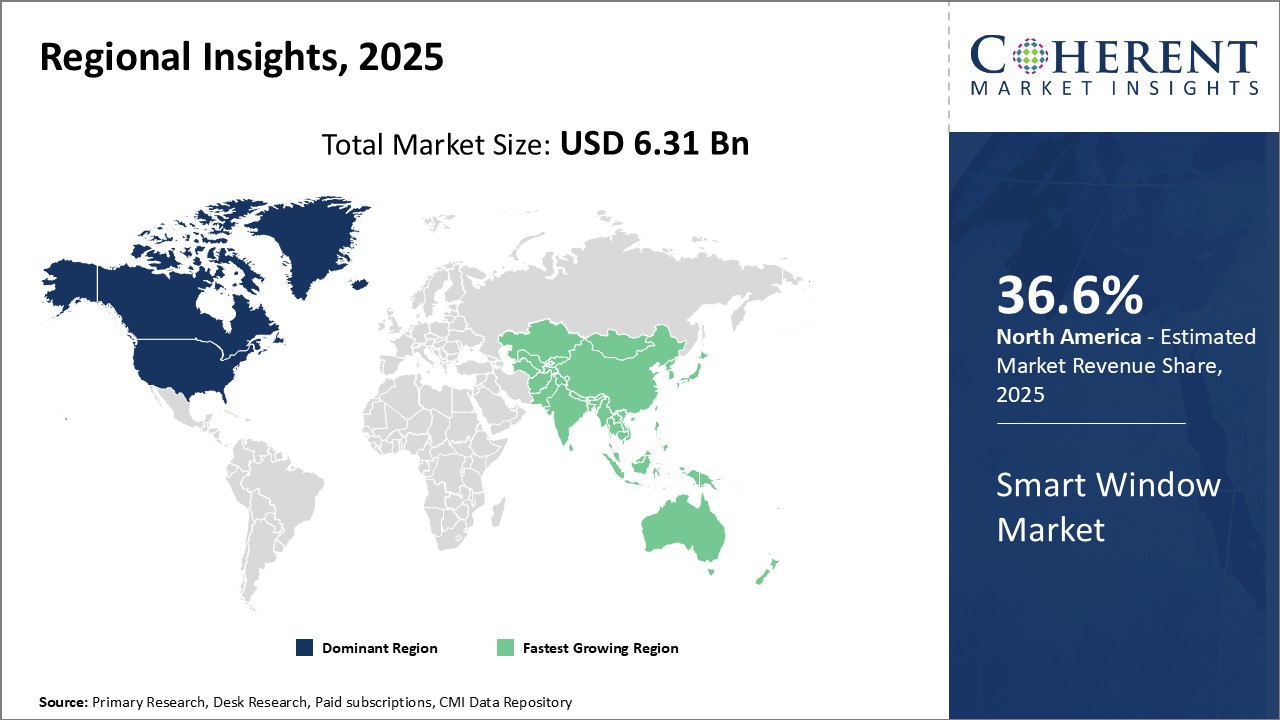Global smart window market is estimated to be valued at US$ 6.31 Billion in 2025 and is expected to reach US$ 12.00 Billion by 2032, exhibiting a compound annual growth rate (CAGR) of 9.6% from 2025 to 2032.

Discover market dynamics shaping the industry: Download Free Sample
The growing construction industry across the world especially in developing countries is the primary factor driving increased demand for smart windows. The smart window market is expected to witness significant growth over the forecast period. Advancements in smart glass and sensor technologies that allows windows to change properties according to outside temperature, light and weather conditions are increasing their adoption. Growing focus on energy conservation and rising consumer preference for aesthetically appealing and multifunctional windows will further boost demand for smart windows among residential and commercial end-users. Rapid urbanization along with increasing green building construction will provide continued impetus to market expansion through 2032.
Market Driver - Growing demand for energy-efficient buildings and sustainable architecture
Energy efficiency in buildings has become a major focus area globally in the past decade. With rising energy costs and greater environmental consciousness, both commercial and residential builders are under increasing pressure to develop green and sustainable infrastructure. Smart windows provide an effective solution to significantly reduce electricity consumption from heating and cooling in buildings. By controlling the amount of sunlight, heat and glare entering a building, smart windows help maintain optimal and comfortable indoor environment while minimizing the need for conventional air conditioners and heaters.
As smart window technology continues to advance with the development of more accurate sensors and controls, architects have started incorporating these windows more widely in their designs. Premium office towers and luxury residential projects especially emphasize the use of smart glazing to highlight their green credentials and appeal to environmentally conscious tenants and homeowners. Both new construction as well as large-scale retrofitting projects present major market potential. Government regulations and building codes in many countries now mandate or incentivize the adoption of energy-saving solutions like smart windows. This is compelling more builders to invest in integrating these windows during planning and development stages itself.
Leading manufacturers are cognizant of the market shift towards sustainable architecture and are continuously enhancing their product lines. While historically high costs were a limitation, mass production and new low-emissivity coating technologies have brought down per unit prices significantly. Affordable smart window options are now available for mainstream commercial and housing segments beyond the premium tier. With their ability to deliver sizable savings on energy bills along with aesthetic advantages, smart windows are showing high return on investment for building owners and developers over the long run. This is helping strengthen the business case for wider adoption going forward.

Get actionable strategies to beat competition: Download Free Sample
Increasing awareness of smart home technologies
The concept of a ‘smart home’ equipped with automated devices and IoT-enabled appliances has captured consumers’ imagination in recent years. While initially confined to niche early adopters, growing exposure through reality home shows, celebrity endorsements and technology conventions has brought smart homes into the mainstream. Mass media coverage highlighting the convenience and efficiency benefits of smart features like voice assistants, security cameras, lighting controls and more has accelerated this awareness. The smart home market itself has expanded at a rapid pace with influx of new startups and expanded product portfolios from tech giants.
Within the smart home landscape, smart windows represent an innovative addition that directly enhances comfort, convenience and security. Just as connected security systems and thermostats have taken off, consumers are now more receptive towards the value proposition of switchable smart glazing. Many view it as a high-impact yet affordable smart home upgrade on par with video doorbells and smart locks. The ease of remotely opening curtains/blinds for ventilation using a smartphone creates a ‘wow’ factor that resonates especially well in modern urban households.
For instance, in March 2022, SelectBlinds.com, a leading online retailer of custom window coverings, announced the launch of two new Motorized Architect Roller Shades products. These innovative roller shades are powered by Eve MotionBlinds motors, which are the first smart blind motors available to support both Bluetooth connectivity and Thread, a new smart home technology standard.
Key Takeaways from Analyst:
Global smart window market is expected to witness significant growth over the coming years. Rapid urbanization and increasing construction of green buildings are driving the demand for smart windows that can improve energy efficiency. With growing environmental concerns, governments across regions are promoting the use of smart technologies in windows through various initiatives and investments.
North America currently dominates the global smart window market owing to strict building energy codes and rising adoption of advance building technologies. However, the Asia Pacific region is projected to be the fastest growing market with China and India leading the growth on account of increasing construction activities and rising disposable incomes.
On the commercial sector, adoption of smart windows is increasing among corporate offices and hospitals as these windows offer various benefits like glare control and daylight management which enhances occupant comfort and productivity. The residential sector will pick up pace gradually as awareness increases and upfront costs reduced with economies of scale.
High initial costs remain a key restraint to widespread adoption of smart windows currently. However, entry of new players is resulting in price wars which is narrowing the cost differential with conventional windows. Ongoing technological advancements are also making these windows energy efficient and easy to install.
Market Challenge - High installation and material costs
The high installation and material costs associated with smart windows poses a significant challenge for the global smart window market. Smart window technology involves the integration of sophisticated electronics and electrochromic materials within window panes which drive up production costs. Further, specialty glazing and framing are required to incorporate motorized shading and tinting mechanisms. The installation of smart windows also requires extensive labor and technical expertise to wire the system controls. All these factors contribute to significantly higher per unit costs of smart windows compared to conventional windows. The premium pricing of smart windows limits their mass adoption, especially in residential real estate and commercial office spaces where budgetary constraints are a major decision driver. High costs may discourage building developers, homeowners and business owners from upgrading to smart windows and instead opt for cheaper alternatives. For the smart window market to witness broad-based growth, bringing down production and installation costs will be a key imperative.
Market Opportunity - Technological advancements in smart window technologies
The ongoing technological advancements and innovations in smart window technologies present a huge opportunity for the global smart window market to grow exponentially. Continuous R&D is enabling improvements in electrochromic materials that allow for faster switching speeds and require lower power. The advent of all-solid-state solutions is doing away with any mechanical moving parts thus improving reliability. Advances in thin-film coating processes are making it possible to develop smart window solutions that can be easily integrated into new architectural designs. The emergence of internet of things also allows smart windows to be operated remotely as part of smart building automation systems. These technological developments have the potential to drastically reduce the costs of smart windows. Falling prices will accelerate mass adoption across residential and commercial sectors. It opens up opportunities for smart window manufacturers to scale up operations substantially. With enhanced capabilities, smart windows can provide enhanced energy saving, convenience, security and aesthetic appeal to building owners and tenants. The market is set to witness tremendous growth if technological milestones continue to be achieved.

Discover high revenue pocket segments and roadmap to it: Download Free Sample
Insights By Technology Type - Advanced Technology Adoption Drives the Electrochromic Segment
In terms of technology type, the electrochromic segment is estimated to contribute the highest market share of 40.6% in 2025 owing to its advanced technology and superior features over other technologies. Electrochromic technology uses low voltage to reversibly change the light transmission properties of special thin film materials and provides continual modulation of transmitted light from clear to dark states. This allows for the automatic dimming and clearing of windows without the need for manual intervention. The ability to precisely control the amount of light, glare and heat entering a space has made electrochromic technology very popular for use in residential as well as commercial buildings.
Compared to other dynamic glazing options like photochromic and thermochromic, electrochromic technology offers faster switching speeds of just a few seconds to transition between tint states. It also has a much wider tinting range from completely clear to nearly opaque and can be uniformly tinted across the entire surface. The thin film materials used in electrochromic windows are also more durable and offer a longer lifespan of over 20 years with minimal degradation in performance over time. Advanced control systems allow electrochromic windows to be automatically controlled based on parameters like light levels, temperature and occupancy for optimal energy efficiency. Their interactive smart features and internet connectivity for remote operation have boosted their adoption in smart homes and buildings. With continued technological improvements focusing on film durability, switchability, aesthetic appeal and lower manufacturing costs, the electrochromic segment is expected to further strengthen its leading position in the global smart window market.
Insights By Application - Residential Demand Drives Application in Buildings
In terms of application, the residential sector segment is estimated to contribute the highest market share of 35.3% in 2025 due to the demand for smart windows. Rapid growth of the global smart homes market along with rising consumer inclination towards energy efficient, automated living spaces is a key factor fueling residential adoption of smart windows. Homeowners are increasingly opting for smart windows to reduce energy bills, maintain comfortable indoor conditions and bring more natural light into living areas automatically without manual controls. Advanced multi-functional windows that can enhance residential aesthetics while providing solar control, security, natural lighting and acoustics have become very popular additions to new construction as well as home renovation projects globally.
Growing consumer awareness about green building concepts and sustainable living is also propelling the use of dynamic windows that can self-tint based on outdoor solar conditions, preventing over-heating and reducing the need for artificial lighting, thereby lowering residential carbon footprint and energy consumption. In addition, smart residential windows with integrated voice command systems, smartphone control apps and home automation integration have added an interactive element that is interesting new homeowners and driving replacement demand. While the commercial segment is growing steadily, continued growth in housing sector, real estate markets and rising disposable incomes will ensure the residential application maintains its dominant position in the smart window market.
Insights By End User - Construction Industry Drives Demand from End Users
In terms of end user, the building and construction segment is estimated to lead the global smart window market with 47.9% share in 2025 due to high demand from the commercial real estate and construction industries. Smart windows are increasingly being used in new commercial buildings as well as large-scale construction projects worldwide given their unique ability to actively manage solar heat gain and glare without mechanical assistance. This enhances occupant comfort, reduces energy usage from HVAC systems and lighting, and allows buildings to save on energy costs in the long run through passive solar control.
Commercial construction of office spaces, retail outlets, hospitals and other institutional buildings relies heavily on smart glazing solutions to attain green building certifications and ratings. Rapid growth of green commercial real estate coupled with strict energy efficiency regulations for new structures have boosted smart window installation globally. Many national governments also offer financial incentives and tax rebates to promote energy saving constructions using advanced glazing technology like electrochromic and thermochromic windows. This is a major factor driving their uptake in public infrastructure and industrial buildings. Additionally, reconstruction and renovation of older commercial buildings with smart retrofit windows helps lower energy usage, making it an attractive proposition for real estate owners and facility managers. Hence, the building and construction end user will dominate demand from the smart window market for the foreseeable future.

Need a Different Region or Segment? Download Free Sample
North America has established itself as the dominant player in the global smart window market with the U.S. accounting for the 36.6% share in 2025. This can be attributed to an expanding construction industry and increased focus on energy management in buildings. Major players in the smart window industry have their headquarters situated in the US, which has helped spur product innovations and drive adoption. The region also has a highly developed commercial real estate sector that is increasingly relying on advanced technologies to improve building efficiency. Further boosting the market is strong export demand from Asia Pacific and European nations.
The Asia Pacific region, led by China, is witnessing the fastest growth and emerging as an important market for smart windows. This can be ascribed to rapid urbanization, economic development, increasing disposable incomes, and rising environmental awareness. Especially in China, government policies promoting green building codes and standards are nudging the uptake of efficient solutions like smart windows. Additionally, several foreign players have established manufacturing bases in China to capitalize on cheaper labor costs and supply windows to the domestic as well as export markets. India is another high potential market in the region due to a booming real estate sector and smart city initiatives of the government focusing on sustainable infrastructure.
The Europe smart window market is dominated by Germany, France and the United Kingdom. Strong presence of auto manufacturers is propelling research into electrochromic windows for automotive applications. Meanwhile, EU regulations to reduce building energy usage and carbon footprint are raising specification of smart glazing solutions, especially in the commercial sector. However, pricing remains a restricting factor with smart windows commanding a significant premium over conventional variants. Local players in Europe continue efforts to lower costs through innovative production methods and economies of scale.
In the Middle East, the smart window market is picking up steam due to a surge in construction of modern commercial high-rises and shopping malls with stringent energy efficiency needs. The wealthy Gulf nations increasingly rely on smart windows as a step towards achieving sustainability goals and gaining edge through green credentials.
Smart Window Market Report Coverage
| Report Coverage | Details | ||
|---|---|---|---|
| Base Year: | 2024 | Market Size in 2025: | USD 6.31 Bn |
| Historical Data for: | 2020 To 2024 | Forecast Period: | 2025 To 2032 |
| Forecast Period 2025 to 2032 CAGR: | 9.6% | 2032 Value Projection: | USD 12.00 Bn |
| Geographies covered: |
|
||
| Segments covered: |
|
||
| Companies covered: |
SageGlass (Saint-Gobain), View, Inc., Gentex Corporation, Soladigm, Inc. (View), PPG Industries, Inc., Research Frontiers Inc., EControl-Glas GmbH, Chromogenics AB, AGC Inc., NanoTech Energy, SmartGlass International Ltd., Onyx Solar, TOSOH Corporation, Hitachi Chemical Co., Ltd., and Guardian Industries |
||
| Growth Drivers: |
|
||
| Restraints & Challenges: |
|
||
Uncover macros and micros vetted on 75+ parameters: Get instant access to report
*Definition: Global smart window market involves windows that use switchable glazing to control the amount of light, heat and glare passing through. Smart windows use materials like liquid crystals, suspended particle devices and electrochromic devices to temporarily change the windows' light transmission properties when voltage, light or heat is applied. They provide benefits like reductions in energy costs through climate control, along with increased privacy, security and daylight control for buildings and automobiles.
Share
Share
About Author
Ankur Rai is a Research Consultant with over 5 years of experience in handling consulting and syndicated reports across diverse sectors. He manages consulting and market research projects centered on go-to-market strategy, opportunity analysis, competitive landscape, and market size estimation and forecasting. He also advises clients on identifying and targeting absolute opportunities to penetrate untapped markets.
Missing comfort of reading report in your local language? Find your preferred language :
Transform your Strategy with Exclusive Trending Reports :
Frequently Asked Questions
Joining thousands of companies around the world committed to making the Excellent Business Solutions.
View All Our Clients